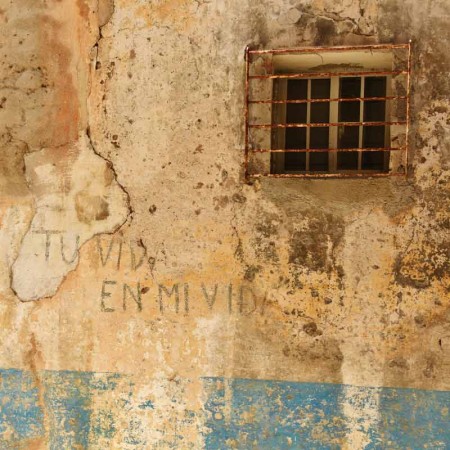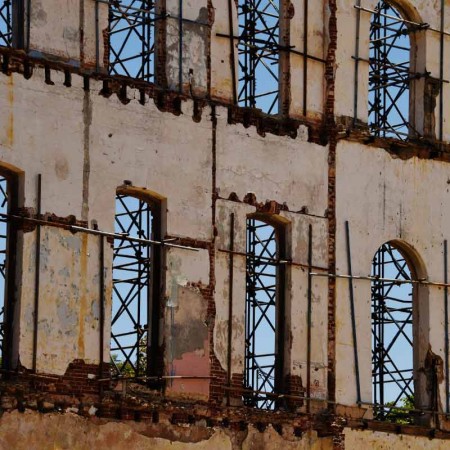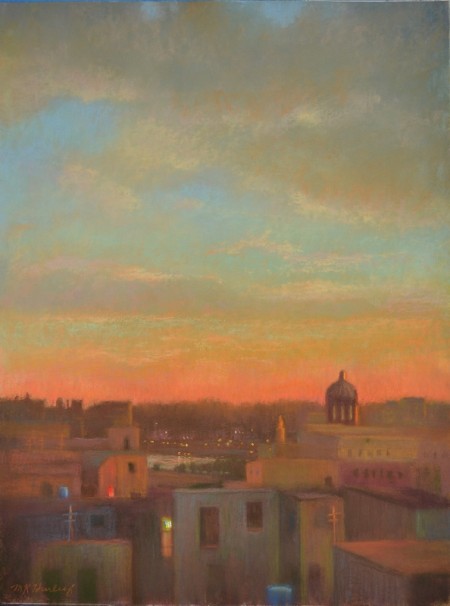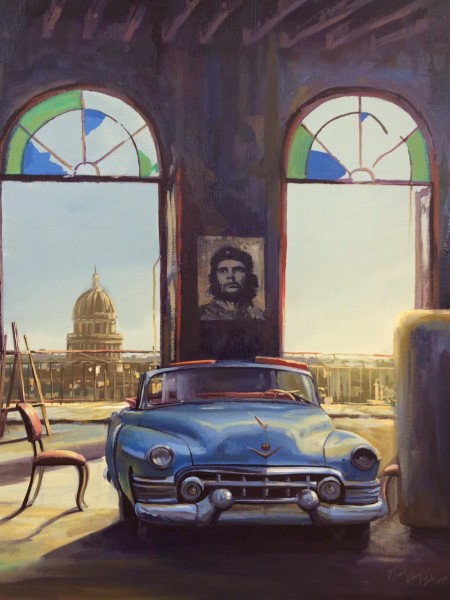The story behind this exhibition, which runs through April 29 at the Clifton Cultural Arts Center, is important. In June 2015 Cincinnati artists M. Katherine Hurley and Jens G. Rosenkrantz, Jr., visited Havana for a week as part of a people-to-people cultural exchange, the only legal way for Americans to travel to Cuba. Such travel is usually done in small groups following itineraries planned by American and local guides. Bravely, Hurley and Rosenkrantz decided to be a group of two. They created their own itinerary—immersion in the art world of Havana—documented their experiences, and arranged in advance to present an exhibition at the Clifton Cultural Arts Center when they returned. Had they been challenged by U.S. Customs to prove they were taking part in a cultural exchange, they were prepared to do so. With a complementary combination of photographs and paintings, “Ahora Cuba” takes us to Cuba just at the moment when relations between the U.S. and the nearby island nation are improving.
Ten large (24X24) photographs by Jens Rosenkrantz hang in the Lobby Gallery of this spacious, inviting arts center. Printed on canvas, these works blend the mediums of photography and painting. Most are close-up shots of buildings; one captures the sensual curves of a vintage blue Chevy. “Tu Vida En Mi Vida,” a picture of a wall on which the words of the song title have been printed, resembles an oil painting in the rich texture of its harmonious earth tones. “Old Havana” depicts a series of arched windows in a roofless ruined building held together by steel reinforcement rods. Brilliant blue sky is seen through the empty windows. Rosenkrantz is attracted by architectural details in the urban landscape. Some buildings, one the Capital of Cuba, are shot in close-up through the grids of scaffolding or iron security bars, breaking the image into segments and emphasizing the architectural elements. Rosenkrantz can shoot engrossing panoramic street scenes, but he is most interesting as a photographer the closer he gets to his subject.


In the same gallery Rosenkrantz has a second series of smaller photographs printed on paper. It would be almost impossible to take a bad picture in a city as picturesque as Havana. Rosenkrantz avoids tourist shots by seeking out unusual subjects: a nude mannequin in the shadows of a shop; obscure figures in an oddly curved tunnel in El Morro, the old Spanish fort in Havana harbor, that somehow looks like a modern building in this photograph; an empty highway with the tall and surprisingly fanciful streetlights found in Cuba. There is an element of mystery in each of these works. In “Room with a View” the Capital is seen through a window beaded by drops of rain water. “Havana after the Rain,” was shot with what appears to be water on the bottom of the camera lens, giving this large panoramic urban landscape a pointillistic effect. Rosenkrantz’s tendency to put some element between himself and his subject is one of his most distinctive traits as a photographer.
M. Katherine Hurley is well known in Cincinnati as a landscape painter. In “Ahora Cuba” she exhibits her photography for the first time, perhaps inspired to do so by her collaboration with Jens Rosenkrantz. Not surprisingly, color is a primary element in her work with the camera, especially the colors so characteristic of Cuban buildings, yellow, pink, blue. A few of her photographs have been hand colored. “Man vs. Machine” captures a bicyclist riding alongside a bright yellow bus. The yellow of the bus is repeated in the yellow trim on a building in the background, creating a painterly sense of harmony. “Chartreuse Wall” is equally effective although the beautiful colors are purely natural. While Rosenkrantz, a cerebral photographer, is drawn to public spaces, Hurley’s feeling eye is attracted by domestic scenes, evident in her titles, “Laundry Day,” “Sunday Chores.” The latter, a detailed image despite being shot from some distance, shows people in the common space outside their houses. The picture tells the story of where and how Cubans live as effectively as any words. In one picture we see a man selling brooms, in another a worker hammering iron on a sidewalk. “No More Crutches” takes us inside a Cuban house, small, tidy, but obviously impoverished. “Coffee Break” portrays a woman on a terrace, a beautiful spectrum of colors in the walls of the houses behind her and a bright red water drum drawing the viewer’s attention in the center of the photograph. A painter could not have composed this scene more effectively. Two related works, profound in their simplicity, seem to point to the future of Cuba. “Waiting” is the portrait of a young girl waiting for a bus; “Errand Boy” shows a boy in the foreground with one of the ubiquitous posters of Che in the background.

Hurley’s photographs, which are beautiful without being conventionally picturesque, benefit from her skills as a painter. In addition to the hand painting, they have been cropped and edited and in some the color has been pushed. Taken together, they give a vivid and affectionate impression of Cuba. Upon her return, Hurley also completed five original paintings for this show. Four are impressionistic Havana cityscapes. They show the influence of her landscape paintings. Shadowy buildings are seen beneath a brilliant sky at sunset. Hurley explains that two of the paintings were repurposed, something common in embargo-plagued Cuba. “La Noche Havana,” a 48X60 oil, was painted over an unfinished painting of an Italian scene. These are the works of a seasoned painter, each beautiful in its own right, but they are less successful than the other components of this show in giving a distinct impression of Cuba.

The final section of “Ahora Cuba,” for which we can be very grateful to Kay Hurley and Jens Rosenkrantz, is an exhibit of 23 works by Cuban artists they were able to purchase and bring back to the States. This section includes a display of passages from the journal Hurley kept in Havana and photographs of many of the artists. One touching fact is that the names of two of the artists are unknown because they were lost in the language barrier between Cubans who do not speak English and Americans who do not speak Spanish. As collected by Hurley and Rosenkrantz, the Cuban artists demonstrate amazing variety. There are abstracts, portraits, cartoons, photographs, and, of course, renderings of vintage American cars. We see the faces of Cubans in many of these works. Not one artist focuses on the decay so noticeable to Americans who visit Cuba. “Microwave Flag” is a very political photograph by Gringo. A wonderfully conceived oil by Lalo shows his grandfather’s vintage Cadillac in center of a dream-like room. A chair sits next to the Cadillac, which represents the family’s dining table, the car having been used as a taxi to feed the family. In the background is the Capital of Cuba and to the side a picture of Che. This painting tells the story of a family and a country. It is also a masterful work by an artist from “Cuba Now.”

“Ahora Cuba” succeeds in many ways. M. Katherine Hurley and Jens Rosenkrantz are accomplished artists whose work warrants attention. Cuba provided them with an opportunity to wed their talents and share the results with Cincinnati. And no one can view the necessarily small but wonderfully varied collection of works by “Los Artistas de la Habana” without wanting to travel to Cuba and see more.
–Daniel Burr